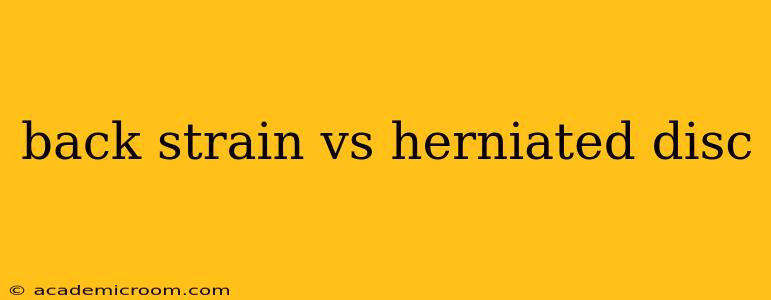Back pain is a common ailment, affecting millions worldwide. Two frequent causes are back strain and herniated discs. While both can cause significant discomfort, understanding their differences is crucial for proper diagnosis and treatment. This article will explore the key distinctions between back strain and a herniated disc, addressing common questions and concerns.
What is a Back Strain?
A back strain, also known as a muscle strain or sprain, involves an overstretching or tearing of the muscles and ligaments in your back. This typically occurs due to sudden movements, lifting heavy objects improperly, or repetitive strain. The pain is often localized to the affected area and may be accompanied by muscle spasms and stiffness. The severity can range from mild discomfort to debilitating pain.
What is a Herniated Disc?
A herniated disc, often called a slipped or ruptured disc, occurs when the soft, gel-like center of an intervertebral disc pushes through a tear in the tough outer layer. This can put pressure on nearby nerves, causing radiating pain, numbness, tingling, and weakness in the legs or arms (depending on the location of the herniation). Unlike a back strain, a herniated disc often involves neurological symptoms.
What are the Symptoms of a Back Strain?
Symptoms of Back Strain:
- Localized pain: The pain is generally concentrated in the affected muscles of the back.
- Muscle spasms: Involuntary contractions of back muscles can lead to significant stiffness and pain.
- Stiffness: Difficulty moving or bending your back is a common symptom.
- Tenderness to the touch: The affected area may be sensitive to pressure.
- Pain that improves with rest: While the pain may be significant, it often eases with rest and reduced activity.
What are the Symptoms of a Herniated Disc?
Symptoms of a Herniated Disc:
- Radicular pain: Pain that radiates down the leg or arm, following the path of a nerve. This is a key differentiator from a back strain. This is often described as sciatica if it radiates down the leg.
- Numbness and tingling: Sensations of pins and needles or numbness in the leg or arm.
- Weakness: Muscle weakness in the leg or arm.
- Decreased reflexes: Reduced reflexes in the affected leg or arm.
- Pain that may worsen with certain movements or positions: Certain postures or activities might exacerbate the pain.
How are Back Strain and Herniated Disc Diagnosed?
Both conditions are typically diagnosed through a physical examination. Your doctor will assess your symptoms, range of motion, and neurological function. Imaging tests, such as X-rays, MRIs, or CT scans, may be used to confirm the diagnosis, particularly in cases of suspected herniated discs. X-rays primarily show bone structure, while MRI provides a detailed view of soft tissues, including discs and nerves.
How are Back Strain and Herniated Disc Treated?
Treatment for both conditions often involves conservative approaches initially. These may include:
- Rest: Avoiding activities that aggravate the pain.
- Ice and heat therapy: Applying ice packs initially to reduce inflammation, followed by heat to relax muscles.
- Over-the-counter pain relievers: Medications like ibuprofen or acetaminophen can help manage pain and inflammation.
- Physical therapy: Exercises to strengthen back muscles and improve flexibility.
For herniated discs, more intensive treatments might be necessary if conservative methods fail to provide relief. This could involve epidural steroid injections or, in rare cases, surgery. Surgery for a herniated disc is usually only considered if there's significant nerve compression causing severe or persistent neurological deficits. Back strain, on the other hand, generally resolves with conservative care.
How Long Does a Back Strain Last?
The duration of a back strain varies depending on its severity and the individual's response to treatment. Most back strains resolve within a few weeks with proper rest and care. However, some may persist for several months.
How Long Does a Herniated Disc Last?
The recovery time for a herniated disc is also variable. Some individuals experience significant improvement within weeks or months with conservative management. Others may require more extensive treatment and have longer recovery periods. In some cases, symptoms may persist for an extended time, even with treatment.
Can a Back Strain Turn into a Herniated Disc?
While a back strain itself doesn't directly transform into a herniated disc, repetitive strain and improper lifting techniques can contribute to the degeneration of intervertebral discs, increasing the risk of a herniated disc in the future.
When Should I See a Doctor?
It's essential to consult a doctor if your back pain is severe, doesn't improve with rest, or is accompanied by neurological symptoms like numbness, tingling, or weakness. These symptoms could indicate a more serious condition, such as a herniated disc, requiring medical attention. Prompt diagnosis and appropriate treatment can help prevent complications and improve outcomes.
